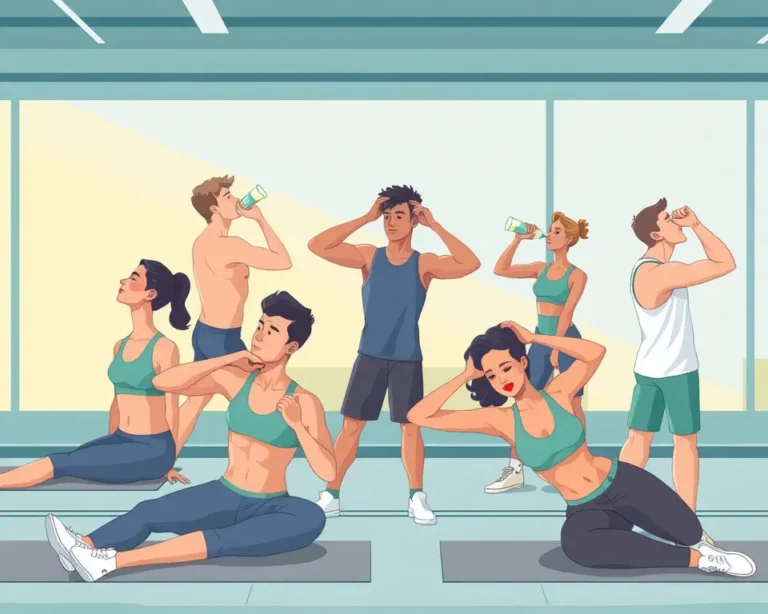Working out is a crucial part of a healthy lifestyle, but what you do after your workout is just as important. A proper cool down routine can be the secret weapon that helps you come back stronger, prevents injuries, and maximizes your workout results. Many people focus on pushing their limits during exercise, often neglecting the vital self-care needed afterward. But experts agree that post-workout recovery is as essential as the exercise itself.
Why Cool Down? Unlocking the Power of Recovery
Cooling down allows your heart rate and blood pressure to gradually return to pre-exercise levels. Suddenly stopping can cause lightheadedness or even fainting because your heart rate and blood pressure drop too rapidly.
Here’s why incorporating a cool-down routine into your fitness regimen is a game-changer:
- Prevents Blood Pooling: When you exercise, your heart pumps blood to your muscles. Suddenly stopping can cause blood to pool in your legs, leading to dizziness. A cool down helps maintain blood flow, preventing this issue.
- Reduces Muscle Soreness: Cooling down helps flush out metabolic waste products like lactic acid that accumulate during intense exercise, reducing muscle stiffness and soreness.
- Enhances Flexibility: Stretching during your cool down, when your muscles are still warm, can improve flexibility and range of motion, reducing the risk of injury.
- Promotes Relaxation: A cool down can help your mind and body transition from an energetic state to a relaxed state.
- Speeds Up Recovery: By increasing blood flow to your muscles, a cool down speeds up the recovery process, preparing your body for your next workout.
The Ultimate 4-Step Cool Down Routine
Here’s a simple yet effective 4-step cool down routine to incorporate after every workout:
Step 1: Low-Intensity Cardio
After your workout, spend about 5-15 minutes engaging in low-intensity movements, such as walking, light jogging, or cycling at a reduced pace. This helps gradually lower your heart rate and prevent blood from pooling in your muscles.
- Walking: A gentle walk allows your heart rate to decrease gradually.
- Slow Jogging: A light jog can help flush out waste products from your muscles.
- Cycling at Reduced Pace: Easy cycling is a great way to keep your muscles moving without overexerting them.
Alternating between movements allows your body to gradually transition from the stress of the workout to a more relaxed state; this process is key in preventing muscle stiffness and helping your body recover more efficiently.
Step 2: Dynamic Stretching
After the cardio portion of your cool-down, incorporate dynamic stretching to further improve flexibility and reduce muscle tension. Dynamic stretches involve controlled movements that take your muscles through a full range of motion.
- Arm Circles: Slowly rotate your arms forward and backward to loosen up your shoulder muscles.
- Leg Swings: Gently swing your legs forward and backward, and then side to side, to improve hip mobility.
- Torso Twists: Twist your torso from side to side to loosen up your spine and core muscles.
- Cat-Cow Stretch: Start on your hands and knees, and alternate between arching your back (like a cat) and dropping your belly (like a cow) to improve spinal flexibility.
Step 3: Foam Rolling
Foam rolling, often referred to as self-massage, targets muscle tension and aids in soft tissue recovery. This technique can alleviate discomfort and reduce muscle soreness.
- Calves: Sit with your legs extended and place the foam roller under your calves. Use your arms to lift your hips off the ground and roll from your ankles to your knees.
- Hamstrings: Similar to the calf roll, place the foam roller under your hamstrings and roll from your knees to your glutes.
- Quadriceps: Lie face down with the foam roller under your thighs and roll from your knees to your hips.
- Glutes: Sit with the foam roller under one glute, cross the opposite leg over your knee, and roll back and forth.
- Upper Back: Lie on your back with the foam roller under your upper back and roll from your mid-back to your shoulders.
Step 4: Static Stretching and Deep Breathing
Finish your cool down with static stretches, holding each stretch for approximately 30 seconds. Focus on stretching the muscle groups you used during your workout. This helps improve flexibility and reduce muscle stiffness. Pair your stretches with deep breathing to promote relaxation and reduce stress.
- Hamstring Stretch: Sit on the floor with your legs extended and reach for your toes.
- Quadriceps Stretch: Stand and pull one leg behind you, holding your foot with your hand.
- Calf Stretch: Place your hands against a wall and lean forward, keeping one leg straight and the other bent.
- Triceps Stretch: Reach one arm overhead and bend it behind your head, using your other hand to gently pull your elbow.
- Shoulder Stretch: Bring one arm across your body and use your other arm to gently pull it closer.
- Child’s Pose: Start on your hands and knees, then sit your butt back on your heels. Drop your head and walk your hands forward as far as you can without your butt lifting from your heels.
Maximizing Your Recovery: Beyond the Cool Down
While the 4-step cool down routine is crucial, there are other factors that can significantly impact your recovery and enhance your workout results:
- Hydration: Drink plenty of water before, during, and after your workout to replenish fluids lost through sweat.
- Nutrition: Consume a balanced diet with adequate protein and carbohydrates to support muscle repair and growth. Aim to consume a combination of protein and carbohydrates within 30 minutes post-exercise to replenish energy stores and promote muscle repair.
- Sleep: Aim for 7-9 hours of quality sleep each night to allow your body to recover and rebuild muscle tissue.
- Rest Days: Incorporate rest days into your workout schedule to give your muscles time to recover.
- Active Recovery: Engage in low-intensity activities, such as walking or yoga, on your rest days to promote blood flow and reduce muscle stiffness.
Listen to Your Body
It’s essential to listen to your body and adjust your cool down routine and recovery strategies accordingly. If you’re experiencing excessive muscle soreness or fatigue, consider reducing the intensity of your workouts or taking more rest days.
The Takeaway: Recovery is Key
Don’t let your hard work go to waste by neglecting your post-workout recovery. By incorporating this 4-step cool down routine and prioritizing other recovery strategies, you can reduce your risk of injury, minimize muscle soreness, and maximize your workout results. Remember, recovery is not a luxury; it’s a necessity for achieving your fitness goals and maintaining a healthy lifestyle.







